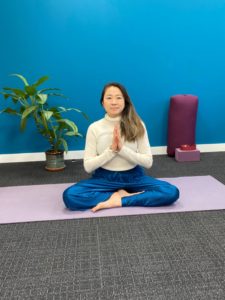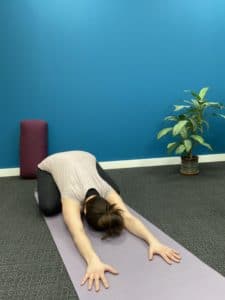Following February’s blog post on the importance of an embodied yoga practice as part of your eating disorder recovery, here are some wonderful poses you could try at home to help you feel calm, soothed, and energised.
Yoga as an embodied practice
Yoga is a holistic practice that helps to bring more balance, understanding, and ease to your mind, body and spirit. It’s a practice that helps you to take care of yourself. Yoga facilitates this process through embodiment.
Put simply, embodiment is the practice of bringing your awareness back to your feeling and sensing body. Many people describe embodiment as the experience of engaging oneself ‘in the world through the experiences we feel in our body, through our body, and perceived through our body.’
In the modern world, the body is often disregarded and minimised as some ‘thing’ we need to sculpt, change, and adorn so we can get on with what the mind wants us to do. This view is a great error. Yoga and embodied practices help us to understand that the body can be our greatest informant and teacher.
As an embodied practice, yoga invites us to listen and look deeply into our internal body. Yoga asks: What am I noticing in my body, in this moment? Which sensations are present in my throat, the back of my head, my neck, and toes? Which thoughts are these sensations creating in my mind? How does joy, fear, and anxiety manifest in the body?
Embodied yoga is particularly beneficial for those struggling with an eating disorder because it’s a very gentle way of establishing a new relationship with your body. One that is caring and curious rather than judgemental and critical.
The truth is, recovery cannot occur without re-establishing a new relationship with your body and internal self. Embodied yoga will help you to begin this process.
Preparing for your yoga practice at home
Here are three simple yoga poses for you to try at home. Allow yourself to be a slow learner, and remember there is no ‘right’ or ‘wrong’ way to practice. It doesn’t have to be scheduled or planned out, and you don’t need any special equipment. Yoga is totally portable.
To begin, find a safe and comfortable space that’s just for you, away from technology and distractions (if possible).
- You can enjoy these practices any time you notice yourself feeling stressed, tense, anxious, or when you notice difficult thoughts creeping in.
- If you need a break from your work, these practices help to offer respite. A moment to step away from all your roles and responsibilities, to pause, stabilise your attention, and reset with renewed energy.
- You can also include these practices as part of your morning and evening routine. They’ll help you to connect with your body, get in touch with how you’re feeling, and start or finish your day in a way that helps you to take care of your mind and body.
You can combine all three poses into one practice, or pick a particular pose to suit your needs in the moment:
- Prayer pose – to feel centred, connected, and calm
- Child’s pose – to feel soothed, grounded, and to release tension held in the body
- Chest and heart opener – to feel energised and open
When you slow down and connect with yourself on the mat, be curious about where your attention is. When your attention leaves your body and breath, gently guide it back to the feeling and sensing body. The point is not to force your attention to stay on your body but to notice when you leave your body and become stuck in the realm of thought.
3 gentle yoga poses to help support your eating disorder recovery
1. Prayer pose
Why we love this pose:
This is a great centring pose that will help you come back to your body and connect with your heart, and your deepest wishes for yourself. This pose will also help steady your attention and bring you back to the present moment.
Let’s practice
To practice, take yourself away from your work, to an uncluttered space (if possible).
- Sit or stand in a comfortable position so that your spine is elongated and upright, but not strained. A posture that embodies wakefulness brings energy to the mind and body.
- Bring your palms together so that each of your fingers is touching its counterpart on the opposite hand. Notice the temperature and sensations in your palms as your fingers come to touch. You can place your praying hands slightly in front of your chest, or gently press them into the centre of your chest. Tweak the position of your prayer pose so that it feels just right for you.
- Close your eyes or fix your gaze to a neutral point on the ground. Allow your eyes to be soft, if your eyes are open.
- Bring awareness to the breath in your body, and the sensations in your hands.
- Allow any thoughts to come and go without identifying with them. Simply pay attention to how you’re feeling in the body.
- Then, gently bow your head to your heart by tucking your chin slightly toward your chest. Surrender your head to your heart, and as you do so, you can offer a well meaning wish or prayer to yourself. For example, you can gently offer yourself these loving words: “May I be patient with myself.” “May I be gentle with myself.” You can choose to rest your hand over your heart while you do this.
- Continue to release any tension that has built up from the day with each out-breath, while drawing new energy into the body with each breath in.
- Release your hands and place them by your sides or on your lap when you are ready to come out of the pose. Notice how you are feeling in your body after this short moment of self-connection.
2. Child’s pose
Why we love this pose:
Child’s pose aims to bring your mind and body back to a restful and childlike state. A child’s mind is often simpler and free of overthinking, judgements and worries.
This pose also invites you to protect yourself as you would a child by drawing your body close, feeling the support of the earth below you.
If you’re feeling overwhelmed, stressed, or overstimulated, this pose can offer immediate grounding, comfort, and will be soothing.
Let’s practice
To practice, you will need a yoga mat, a towel, or simply a carpeted floor.
- Position yourself on your hands and your knees. Walk your hands slightly in front of you, and allow your big toes to touch. Then, gently walk your knees wider than hip width apart.
- Gently curl your neck toward your chest and as you look toward your navel, push your buttocks towards your heels, and allow your torso to rest in between your knees.
- Bring your forehead down to the mat and allow yourself to feel the wonderful support of the ground below you, as you are being held.
- For a deeper stretch, press your palms firmly into the floor, and lift your elbows away from the mat.
- For a gentler stretch, relax your shoulders completely and allow your palms to face up or down.
- Take 8 – 10 rounds of slow, deep, and even breaths, in through the nose and out through the mouth.
- Hold the intention to comfort, soothe and take care of yourself. Remember, you’re not practising yoga to ‘get rid’ of a feeling. Rather, we practice yoga because it is a better way to respond to stress and distress held in mind and body.
- To come out of the pose, gently press your hands into the mat and lift your torso up and find a sitting position.
- Take some time to remain in stillness and notice the benefits of the pose.
3. Chest and heart opener
Why we love this pose:
The chest and heart opener brings new energy into the body. It opens up the gateways of your lungs, your heart centre, and brings relief to your back and tight shoulders.
It’s a good idea to practise this pose if you’ve been working by your desk for long hours, or need to have a little stretch. It will help you to feel more at ease in your mind and body.
Let’s practice
- Stand comfortably with your feet hip width apart.
- Move your hands behind your buttocks and interlace your hands together. Your upper arms should face outwards as your hands are interlaced.
- Push your interlaced hands down and toward the ground so that your knuckles are facing downward, and your arms are straightened. You will feel your inner shoulder blades deepen into your back ribs and your chest will naturally broaden and open up.
- You can use an object such as a half-filled water bottle, a rolled-up towel, or a folded yoga strap if you’re not able to clasp your hands behind your back. Simply hold on to both ends of the object behind your buttocks, with your palms facing inward. Press the prop of your choice down toward the ground.
- You can gently lift your gaze upward without straining your neck, or simply look straight ahead. You may even close your eyes, if you feel comfortable maintaining your balance in this pose.
- Take 3 – 5 rounds of deep breaths before moving out of the pose.
- To come out of the pose, simply remove the clasp in your hands, and return to a neutral standing position.
- Take a moment to check in and notice the benefits this pose had on your body and mind.
Remember to set your intention
Try to recognise what you need in the moment and set your intention for your practice to calm, soothe, or energise your body. Try to hold that in your mind and see where that intention leads you.
You may notice thoughts appearing in your mind as you practice. This could be a thought about the future or the past. Perhaps your mind is planning or figuring something out.
When this happens, congratulate yourself for noticing that your mind is taking you away from your body, from the present moment. Simply notice when the mind wanders away, and gently guide your attention back to your breath, back to the sensations you are feeling in your body as you are holding the pose. That is the challenge – to come back to the body when the mind tries to pull you away, and to do so without judgement.
Of course, this is easier said than done, and that’s precisely why this is called a ‘practice’!
We practice to discover more of ourselves and to develop a more gentle and kinder way of relating to ourselves, rather than to seek perfection or get rid of a particular feeling or thought.
Remember, it’s all about your intention, and about making those baby steps.
You can see the Altum Health team practice these yoga poses on our Instagram feed.
Our licensed, professional therapists specialise in the treatment of eating disorders, and are here to help. Please contact us to book a consultation.





